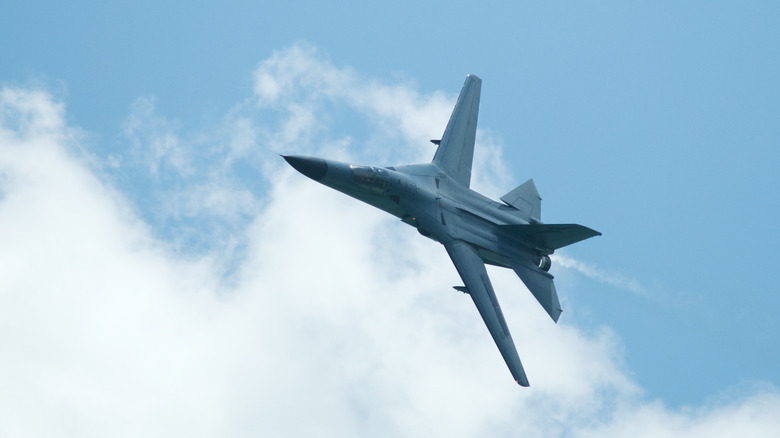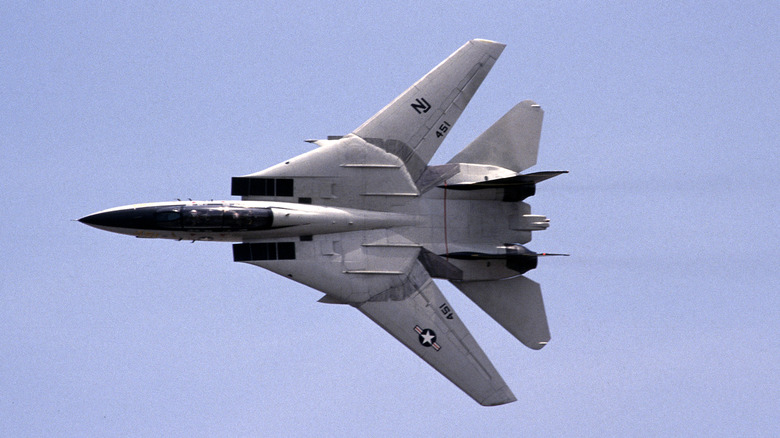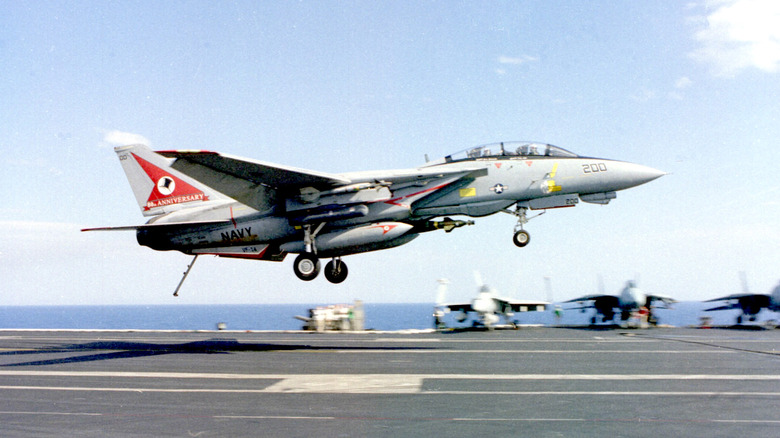How The F-111 Strike Aircraft Led To The Iconic F-14 Fighter Jet
In the 1960s, the U.S. military tried to solve two problems with one aircraft. Then-Secretary of Defense Robert McNamara pushed the Tactical Fighter Experimental (TFX) program, hoping to create a single jet for both the Air Force and Navy. That meant one airframe to serve as a land-based bomber and a carrier-based fleet defender. The result was the General Dynamics F-111 Aardwark (now retired): a variable-geometry wing aircraft specialized for each service. The Air Force got the F-111A, a low-level strike bomber. The Navy got the F-111B, a long-range interceptor armed with AIM-54 Phoenix missiles. But that didn't work out.
The Navy's F-111B suffered from critical flaws, despite being one of the fastest bombers ever made. It was too heavy for carrier operations, nearly 10,000 pounds above the desired weight target. Pilots also complained of poor visibility during landing and underwhelming acceleration on final approach.
By the time the F-111B reached carrier testing, it had earned a reputation as sluggish, unstable, and downright dangerous for Navy missions. Only one prototype ever touched down on a carrier. The rest never made it that far. Ultimately, even top brass at the Navy admitted it was unfit. Vice Adm. Tom Connolly famously declared: "There isn't enough thrust in all Christendom to make a Navy fighter out of that airplane." So the Navy canceled it in 1968.
The VFX program replaced the F-111B with a new fighter — the F-14 Tomcat
After scrapping the F-111B, the Navy wasted no time launching a new effort to find a better fleet defender. The program was called VFX. Its goal: build a carrier-based interceptor that could defend a battle group from Soviet bombers and cruise missiles. It was what the F-111B was supposed to do, but couldn't manage. Grumman won the competition with its Model 303, which would go on to become the famous F-14 Tomcat.
Grumman knew what didn't work with the F-111B. Instead of copying the same heavy design, it took the swing-wing concept and made it leaner and better suited to carrier ops (turning it into one of the latest swing-wing fighters to enter military service). The F-14 kept the long-range AIM-54 Phoenix missiles and the AWG-9 radar system originally developed for the F-111B, but ditched the rest. Engineers created a whole new airframe with twin tails, a wide fuselage for extra lift, and variable geometry wings that folded for storage and changed sweep automatically in flight.
The F-14 first flew in 1970 and entered Navy service in 1974. It could carry six Phoenix missiles and fire them at multiple targets simultaneously, something the Navy had wanted all along. The AWG-9 radar could track targets over 100 miles away. The Tomcat was fast, too (topping out at Mach 2.34), and had enough agility to hold its own in a dogfight. Grumman's designers later admitted that the F-111B failure taught them everything they needed to know to build the Tomcat right.
Lessons from the F-111 shaped the F-14's design — but the Tomcat was a major leap forward
The F-14 didn't just clean up the F-111B's mess. It became one of the most advanced fighters of its era. While the Tomcat owed its origins to the F-111 (including the radar, missile system, and swing-wing tech), it was far more than a fixed version. According to Grumman's Mike Ciminera, over 6,000 configurations were tested before finalizing the Tomcat's design. Every detail was re-engineered to solve the problems that doomed the F-111B.
The Tomcat's wings could swing automatically between 20 and 68 degrees depending on speed and maneuvering. On carriers, the wings could oversweep to 75 degrees for easier stowing. Its twin Pratt & Whitney TF30 engines were a carryover from the F-111 but were later upgraded to General Electric F110-GE-400s. The F-14's body generated extra lift, helping with low-speed carrier landings, a weak point on the F-111B.
Weapons integration also moved forward. In addition to long-range Phoenix missiles, the F-14 carried AIM-7 Sparrows, AIM-9 Sidewinders, and a 20mm cannon. Its radar and IR tracking gear gave it an unmatched targeting range at the time.
More than just a product of lessons learned, the Tomcat was a technological leap. It wasn't just built to avoid the F-111B's mistakes; it set the bar for what a modern carrier-based air superiority fighter could be. The Navy didn't get what it wanted with the F-111, but the F-14 more than made up for it.


